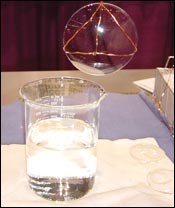The molecular nature of water makes it difficult and costly to remove from precision metal, plastic, glass or ceramic components. According to MicroCare Corp. (New Britain, CT), this is particularly true when part geometry makes it difficult to get all the water off parts being cleaned, or when the cleaning requirement is so stringent that absolutely no water spots can remain on the parts—for example, when drying components before the deposition of a high-tech coating.
“Because of these complexities, a process called ‘solvent drying’ or ‘solvent dewatering’ is widely used across Europe,” says MicroCare’s Mike Jones. “But it’s used only occasionally in the U.S. to remove water from precision parts.”
According to Jones, the idea behind solvent drying is to use relatively inexpensive aqueous cleaning solutions and processes for initial cleaning, then finish cleaning with high-purity solvents. “This combination of processes can bring quality, speed, economy and energy efficiency to the drying process,” he says.
Solvent drying is not a new process, but Jones believes few engineers today are familiar with it. And, although the process requires specific solvents and special drying systems, these are neither complex nor overly expensive. “In fact, in the days of ozone-depleting solvents, solvent drying was widely practiced and often found in the jewelry, medical device, optics and ceramics industries,” Jones says. “However, since the phase-out of chlorofluorocarbons (CFCs) and hydrochlorofluorocarbon (HCFC) solvents, there have been few affordable drying solvents.”
According to Jones, new solvent alternatives are helping to bring back solvent drying, and the process is one that engineers involved in precision cleaning of components should consider. “These new solvents are immiscible in water, denser than water and have a lower viscosity than water,” Jones explains. “Low-boiling solvents, such as DuPont’s Vertrel and 3M’s Novec materials, are today’s market leaders.”
And, he adds, the hardware needed for solvent drying is relatively simple. “There are two general types of drying systems: batch dryers and cascading dryers,” Jones says. “Batch dryers are based on standard two-sump vapor degreasers. Less-common cascading dryers move the parts up a progression of solvent baths, which rinse residual water away. Both systems generally use common refrigeration and hoist subsystems, but add jumbo water separation sub-systems to remove the water from the solvent.”
And, various levels of drying are available depending mainly on the quantity of water to be removed from components. “The gold-standard of solvent drying is ‘displacement drying,’” Jones says. “Displacement drying submerges parts into a hydrophobic solvent containing a surfactant, which separates the water from the parts. Since these solvents are much heavier than water, they go beneath the water and simply float it away. This step is followed by a rinse in the solvent vapors.” According to Jones, displacement drying is optimal if large quantities of water need to be removed from parts.
A simpler version of the process, called “polar drying,” uses a highly polar solvent such as DuPont’s Vertrel XP to bind with the excess water. “As the solvent is removed from parts, the water is removed with it,” Jones explains. “The solvent then can be recovered and reused, which keeps costs to a minimum. The polar drying process works very well when the quantity of water to be removed is relatively small.”
According to Jones, the benefits of either process can be significant. “Solvent drying has very high throughput,” he says. “Parts emerge clean, dry and at room temperature. Energy consumption is low, especially when compared with air knives and evaporative dryers.
“The combination of spot-free results, low-energy operation, easy re-use and recycling of solvent, high throughput and low operating costs is the major reason solvent dryers are returning to the factory floor,” Jones concludes.
Related Content
Portfolio of Energy-Curable Coatings Launched
PPG's DuraNEXT portfolio includes EB and UV curable coatings, offering rapid, energy-efficient solutions for metal coil coaters.
Read MoreCordless Sprayer Offers 3 Configurations
Titan’s Impact X 120 18V sprayer delivers up to 4 gallons per charge, reducing overspray by 50% and using a single battery system for multiple tools.
Read MoreSolar-Powered Photonic Cooling Enables Energy-Saving Coating
Passive cooling technology can reduce interior temperatures 5-13°C, offering weight, cost and CO2 benefits for cars, construction, aircraft and more.
Read MoreRevolutionizing Battery Production for Electromobility
Fully automated process combines ultrafine cleaning and protective UV coating for battery cells, replacing the need for traditional film wrapping.
Read MoreRead Next
A ‘Clean’ Agenda Offers Unique Presentations in Chicago
The 2024 Parts Cleaning Conference, co-located with the International Manufacturing Technology Show, includes presentations by several speakers who are new to the conference and topics that have not been covered in past editions of this event.
Read MoreDelivering Increased Benefits to Greenhouse Films
Baystar's Borstar technology is helping customers deliver better, more reliable production methods to greenhouse agriculture.
Read MoreEpisode 45: An Interview with Chandler Mancuso, MacDermid Envio Solutions
Chandler Mancuso, technical director with MacDermid Envio discusses updating your wastewater treatment system and implementing materials recycling solutions to increase efficiencies, control costs and reduce environmental impact.
Read More














.jpg;maxWidth=300;quality=90)









